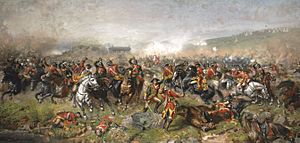John Mulvany facts for kids

John Mulvany (born around 1839 – died 1906) was an artist from Ireland who later became famous in America. He is best known for painting scenes of the American West. One of his most famous works shows General Custer's defeat by the Oglala Sioux Indians at the Little Bighorn in 1876. This huge painting, called Custer’s Last Rally, was finished in 1881. In Ireland, Mulvany is also known for his painting The Battle of Aughrim, which he completed in 1885.
Mulvany also painted scenes from the American Civil War. Throughout his life, he was also a skilled portrait painter, capturing the faces of many people.
Contents
Early Life and Art Training
John Mulvany was born in Diralagh, County Meath, Ireland, around 1839. His parents were tenant farmers. When he was about 12 years old, in 1851, he moved to New York City. He had seen the terrible effects of the Irish Famine before he left Ireland.
In America, he worked as a tow boy on the Erie Canal. There, he caught the attention of Professor Juan Wandersford, who taught at the National Academy of Design in New York City. Mulvany started taking classes at the Academy in 1859. By 1863, he was working for the famous photographer Mathew Brady in Washington, D.C.
Mulvany never joined the army during the Civil War. However, he might have worked as a sketch artist for a newspaper in Chicago. His later paintings about the Civil War were praised for how realistic they were. Some of these paintings include Sheridan’s Ride at Winchester (1896), McPherson and Revenge (1889), Battle of Shiloh, and The Death of General Mulligan.
Studying Art in Europe
After the American Civil War, Mulvany worked for Samuel B. Fassett, a leading photographer in Chicago. He showed his paintings in exhibitions in New York, Chicago, and Philadelphia. A supporter named Samuel B. Coale from St. Louis helped Mulvany go to Europe to study art.
Mulvany enrolled at the Royal Academy of Fine Arts in Munich, Germany. He studied with famous teachers like Alexander von Wagner, De Kaiser, and Carl Theodor von Piloty. Later, he also studied with Jean-Léon Gérôme in Paris, France. He spent time in Antwerp, Belgium, too, studying the works of the old master Rembrandt.
He was classmates with other artists like Walter Shirlaw and Frank Duveneck. Mulvany even won a medal for his artistic efforts. He returned to Chicago in the fall of 1871, just before a huge fire damaged the city.
Becoming a Western Artist
For the next five years, Mulvany traveled and worked in several cities. These included Eldon, Iowa; St. Louis, Missouri; Denver, Colorado; and Louisville, Kentucky. He painted portraits and scenes of the American West.
In 1876, he showed his painting Preliminary Trial of a Horsethief in New York City. This painting reportedly sold for $5,000. It helped him become known across the country as an important Western painter. Other paintings with Western themes include Lynch Law – Comrade’s Appeal (1877), Scouts of the Yellowstone (1877), and Back to the Wigwam (1881).
"Custer's Last Rally"
In 1876, news spread about General George Custer's defeat by the Sioux Indians at the Battle of the Little Big Horn. Mulvany quickly understood how important this event was. He traveled west to Montana to capture the scene on canvas.
Over the next four years, he visited the battle site twice. He set up studios in different cities, including Cincinnati, Salida, Denver, and Kansas City. Mulvany's huge painting, Custer’s Last Rally, was 11 feet tall and 20 feet wide. It was finished in 1881. This masterpiece then went on a seventeen-year tour across the country. Later, H. J. Heinz (from the famous food company) bought the painting in 1898.
"The Battle of Aughrim"
Around 1882, Mulvany received a special request from the Irish Club of Chicago. They asked him to paint the Battle of Aughrim. This battle was a sad defeat for the Irish in 1691. John began making sketches in Ireland in 1882 and finished the large painting in 1885.
For many years, this painting was thought to be lost. However, in 2010, it was offered for sale online by a dealer who thought it was an American battle scene. An Irish art gallery bought it. The painting was then shown in Dublin and later sold to a new owner.
Later Years and Legacy
Mulvany was a member of Clan na Gael, an Irish group working for Ireland's independence. He was researching uniforms for his Aughrim painting at the Tower of London. He narrowly avoided being arrested just days before a bombing there in 1885.
Mulvany painted in many places, including Oregon, San Francisco, Colorado, and Kansas City. He finally moved back East in 1896. Throughout his life, he set up studios in 21 different cities. He would sketch, paint, and then move on to a new place.
In 1897, at age 58, Mulvany settled in the Williamsburg area of Brooklyn, New York. He stayed there for the rest of his life, with a studio at 133 Greenpoint Avenue. He continued to paint major works, including a copy of Custer’s Last Rally. He kept painting and sketching until just two weeks before he passed away in 1906. He is buried in Calvary Cemetery in Queens, New York.
John Mulvany made several important contributions to art. He influenced other artists like William Merritt Chase and Frederic Remington. He also brought a wider, international view to American Western Art. His life story also shows a broader experience of Irish immigrants than is often told. Many of his paintings are still missing today.

